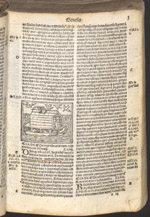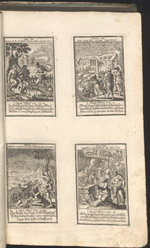Tales of Destruction and Rebirth:
In the Ark
The Book of Genesis does not name any species or any individual explicitly. It simply reproduces the order given by God to Noah before the Flood: “Of every living thing of all flesh, you shall bring two of every kind into the ark, to keep themalive with you; they shall be male and female. […] Two of every kind shall come to you to keep them alive.” The only animal species named are the crow and the dove that Noah sent out after five or six months to see if water had receded. As a result, medieval artists were free to choose the animals they would depict. Their selection reflects the knowledge and mindset of their time. For example, in his book Les Animaux Célèbres (2001) the historian Michel Pastoureau notices the predominance of quadrupeds, led by a “king of animals” (lion or bear), and observes that, during the Middle Ages, horses were seen as “more than animals.” Therefore, they were left behind to perish with their masters in most illustrations of the Flood. Following the great discoveries of the 16th century, exotic animals often replaced unicorns, sirens, and dragons.
How could Noah possibly have packed “every living thing” into a vessel - even if it took him a hundred years to build it? In the 17th century, some scholars tried hard to demonstrate that it was actually possible. Even today, a “scale model of Noah’s Ark” displayed at the Creation Museum established in 2007 in Petersburg, Kentucky, supports the claim that all animals (including dinosaurs) were part of the journey.
 |
Latin Bible. Venice, 1519. [zoom] This image shows Noah and the dove he released to investigate whether the waters have receded: the bird returned with a fresh olive leaf in her beak, showing that the waters abated. He waited another seven days and then sent the dove out again. This time she did not return. To Christians, the story means that God declared peace with mankind after the Flood purged the earth of its wickedness. Later, the Holy Spirit appeared as a dove at Jesus’ baptism, symbolizing peace with God. |
 |
Christoph Weigel. Biblia Ectypa. Nuremberg, 1695. [zoom] The most famous illustrated Bible of the Baroque period was created by German copper engraver Weigel (1654-1725). He selected Biblical episodes as carefully as Noah selected animals. In the case of the Ark, he understood that images of the embarkation invite a richer bestiary than images of the navigation. Like humans, animals are ordered in a strict hierarchy: elephants have precedence over horses, which have precedence over donkeys, etc. |
 |
Athanasius Kircher, S.J. Arca Noë. Amsterdam, 1675. [zoom] | Additional images:  
Nicknamed “the master of a hundred arts,” the German Jesuit Athanasius Kircher (1601-1680) wrote an entire book about the construction and household economy of the Ark. He believed that Noah selected only the “prime types” created by God in the temperate zone, thus ensuring the post-flood recreation of multiple species through cross-breeding, and through mutations due to the various climates and biological environments. For example, he did not preserve the mule (a cross between a donkey stallion and a horse mare), or the giraffe: two leopards and two camels (!) would suffice. In Joscelyn Godwin’s words, Arca Noë is “a virtuoso piece of reconstruction, [which] also serves a secondary purpose of taxonomy, naming and classifying as many animals as possible” - including the rhinoceros (depicted after Dürer’s 1515 famous woodcut), the unicorn, and the siren. Kircher was proud of his demonstration. The text above the ark reads: “Incredulous atheists must admit that the Ark was not lacking capacity to contain comfortably every species of animal found on earth. In fact, there are even some extra stables reserved for those who deride the idea, for they are to be numbered with the beasts.” |